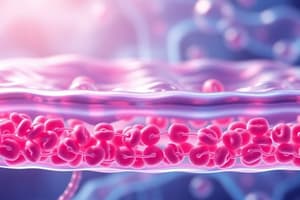Podcast
Questions and Answers
Which of the following is NOT a general function of biological membranes?
Which of the following is NOT a general function of biological membranes?
- Energy production (correct)
- Selective permeability barrier
- Control of the enclosed chemical environment
- Communication between cells
What are the main functions of biological membranes?
What are the main functions of biological membranes?
- Selective permeability barrier and energy production
- Control of the enclosed chemical environment and recognition (correct)
- Communication and signal generation
- All of the above
What is the role of unsaturated fatty acids and cholesterol in membrane fluidity?
What is the role of unsaturated fatty acids and cholesterol in membrane fluidity?
- They decrease membrane fluidity
- They only affect organelle membranes
- They increase membrane fluidity (correct)
- They have no effect on membrane fluidity
What is the process of formation of lipid bilayers?
What is the process of formation of lipid bilayers?
What are the main kinds of lipids found in biological membranes?
What are the main kinds of lipids found in biological membranes?
Flashcards are hidden until you start studying
Study Notes
Membrane Bilayer and its Functions
- The session is about the membrane bilayer and its components.
- The learning outcomes include listing the main kinds of lipids and general properties of fatty acids.
- The session also aims to explain the properties of amphipathic molecules and the process of formation of lipid bilayers.
- The influence of unsaturated fatty acids and cholesterol on membrane fluidity will be discussed.
- The restrictions on protein movement in the membrane, including potential interactions with cytoskeletal elements, will be explained.
- The general functions of biological membranes include acting as a continuous highly selective permeability barrier.
- Membranes also allow control of the enclosed chemical environment.
- Membranes play a role in communication by controlling the flow of information between cells and their environment.
- Recognition is another function of membranes, involving signaling molecules, adhesion proteins, and immune surveillance.
- Membranes are involved in signal generation in response to stimuli, both electrical and chemical.
- Membranes are composed of lipids and proteins.
- The composition of membranes is generally membranous.
Studying That Suits You
Use AI to generate personalized quizzes and flashcards to suit your learning preferences.



